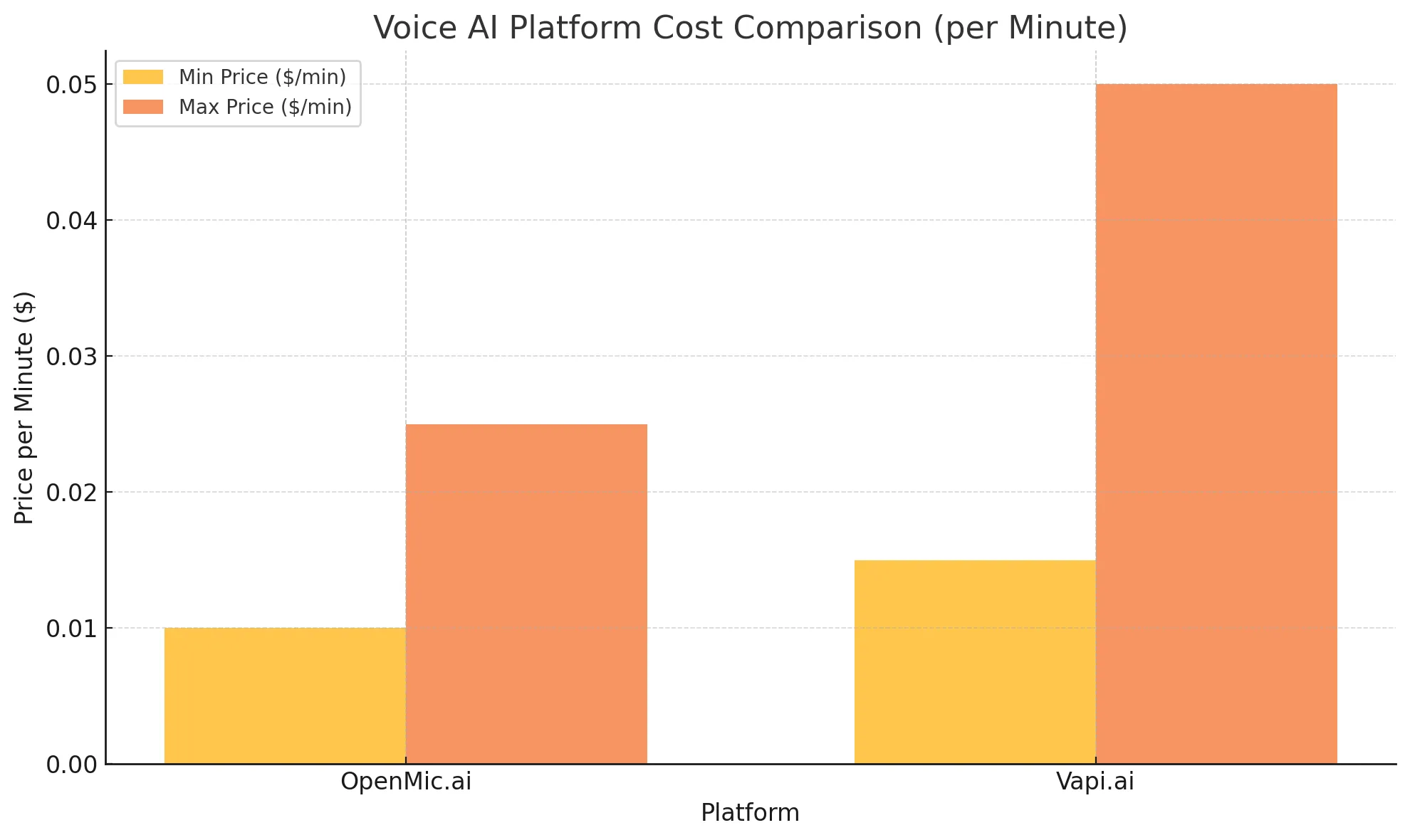.webp)
White-Labeling Voice AI: Is Vapi Worth It for Startup Founders in 2025?
Voice AI technology has revolutionized customer interaction, offering a more personalized, efficient, and engaging experience for users. As the demand for such solutions rises, many startups are exploring white-labeling voice AI platforms to integrate this powerful technology into their own products without having to build it from scratch. One popular option in this space is Vapi, a robust voice AI solution that offers white-label capabilities. However, an important question for startup founders remains: Is Vapi worth the cost, or can alternatives like OpenMic provide a similar solution at a more affordable price?
In this article, we will examine Vapi’s white-label options, how they compare with alternatives like OpenMic, and discuss the advantages and disadvantages of these voice AI platforms for startups. Ultimately, we will provide insights that help you decide which solution is best suited to your needs.
Deliver Voice AI Under Your Brand with White-Labeling
White-labeling in voice AI empowers businesses to integrate advanced conversational technology—like Vapi—into their own platforms, fully branded as their own. Instead of investing years in developing proprietary voice systems, companies can launch voice-powered customer support, sales engagement tools, and AI-driven conversations using a proven backend, while maintaining complete control over the user experience.
Platforms like Vapi offer turnkey features such as speech recognition, natural language processing (NLP), and text-to-speech conversion, making it easy to deliver intuitive voice interactions without revealing the underlying technology. With white-labeling, brands can scale voice AI solutions rapidly while preserving trust and consistency across every touchpoint.
Why Use White-Label Voice AI?
For startups, there are several compelling reasons to choose white-label voice AI solutions:
1. Cost-Effective Access to Advanced Technology
Building a proprietary voice AI system from the ground up is resource-intensive and time-consuming. White-label solutions like Vapi offer startups an affordable way to integrate sophisticated voice AI capabilities without investing in expensive development processes. Developing your own voice AI can easily cost several hundred thousand dollars, not including the ongoing maintenance and updates required. White-label platforms, on the other hand, allow businesses to pay for only the features they need, significantly reducing the overall cost.
2. Faster Time-to-Market
White-labeling a voice AI platform allows businesses to get their product to market more quickly. With pre-built features that require minimal customization, startups can bypass months of development and start offering voice-powered solutions to customers immediately. This is a key factor when competing in fast-moving industries where gaining market share quickly can lead to long-term success. By leveraging a white-label platform, businesses can focus on customer acquisition and growth while leaving the complexities of voice AI to the platform provider.
3. Branding and Customization
Even though the technology is provided by a third party, white-label solutions allow companies to rebrand the system as their own. From the voice’s tone to the design of the user interface, businesses have the flexibility to ensure the voice AI aligns with their brand. This branding flexibility is particularly useful for businesses that want to ensure a consistent customer experience across all touchpoints.
In addition, you can also customize the voice to match your brand's personality. Whether you want a professional, friendly, or casual tone, many white-label platforms offer the option to adjust the AI's speech patterns, ensuring it fits seamlessly into your company's branding.
4. Scalability
A good white-label voice AI solution is built to scale. As your startup grows, you can easily scale up the service to accommodate an increasing number of users, conversations, and tasks, without worrying about technological limitations. Whether you're expanding your customer support team or handling a larger volume of inbound sales calls, scalability ensures that your platform can meet the demands of your growing business.
The ability to scale your platform without encountering technical bottlenecks allows businesses to continue offering top-tier customer experiences, even as the complexity and volume of customer interactions increase.
Vapi AI: An Overview of Its White-Label Capabilities
Vapi AI is a popular white-label voice AI platform that allows businesses to integrate sophisticated conversational AI into their products. Its features include:
- Speech Recognition: Vapi can accurately transcribe speech to text, allowing it to understand and respond to customer queries.
- Natural Language Understanding (NLU): It understands the intent behind user queries, providing intelligent responses. This is crucial for handling complex customer inquiries that involve multiple steps or require contextual understanding.
- Text-to-Speech: Vapi’s AI-generated voices sound natural, making customer interactions smoother. The platform uses advanced voice synthesis techniques to ensure that the AI sounds as human-like as possible.
- Multilingual Support: Vapi supports multiple languages, making it a viable option for businesses operating in diverse regions. This multilingual capability helps expand the reach of your business and enables you to communicate with customers in their native languages.
- Customizable APIs: The platform offers APIs that allow businesses to integrate voice AI capabilities into their existing systems. This customization flexibility is vital for companies that require deep integrations with their existing tech stack.
Vapi AI’s solution is well-suited for companies looking for a developer-centric platform with extensive customization options and developer-friendly APIs.
However, There Are Challenges Associated With Using Vapi, Including:
- High Costs: Vapi’s pricing ranges from $0.015 to $0.05 per minute, which can add up quickly for startups handling large call volumes. It follows a pay-per-use model, often requiring integration with third-party telephony providers like Twilio—adding more to the total cost. While this structure may suit larger enterprises, startups may struggle to manage and predict expenses, especially as usage scales.
- Implementation Complexity: Vapi’s focus on developer-driven customization can require technical expertise, making it less suitable for businesses without dedicated tech teams. If your startup lacks the technical resources to implement the system, you may have to outsource the integration or hire additional developers, which adds to the overall cost.
OpenMic: A Cheaper, But Viable Alternative to Vapi
While Vapi provides a premium solution, OpenMic presents an affordable alternative that still offers robust voice AI capabilities. Here's how OpenMic stacks up:

Advantages of OpenMic Over Vapi: -
Why Pay More for Vapi When You Can White-Label OpenMic AI?
The main question many founders face when evaluating voice AI solutions is: Why pay more for Vapi when alternatives like OpenMic AI provide similar functionalities at a fraction of the cost?
1. Cost Efficiency
For startups that are just beginning to scale, the cost of Vapi can be prohibitive. It offers similar features at a more affordable rate, which is crucial for managing cash flow during the early stages of business growth. By using OpenMic, you can direct your savings toward marketing, product development, or other areas that can drive growth.
2. Ease of Implementation
While Vapi excels in customization, it often requires a developer-centric approach, making it more time-consuming to implement. OpenMic, on the other hand, is designed for ease of use, allowing non-technical users to integrate voice AI into their business solutions without significant technical expertise. For startups that need to move quickly, OpenMic offers a much faster route to deployment.
3. Scalability and Flexibility
Both OpenMic and Vapi are scalable, meaning they can grow with your startup as you expand. Moreover, their pricing structures are more flexible, which is beneficial for startups that may not yet have predictable growth trajectories. With OpenMic, you only pay for what you use, and there are fewer upfront costs, making it easier to adjust as your needs evolve.
Conclusion: Is Vapi Worth It for Your Startup?
Ultimately, whether Vapi is not a bad investment depends on your startup's budget, technical resources, and specific business needs. If your startup has the technical expertise and budget to invest in a more advanced solution, and if your needs align with the high level of customization and deep integration that Vapi offers, then it might be the right choice.
However, for most cost-conscious founders, OpenMic offers affordable, easy-to-implement alternatives that deliver robust voice AI capabilities without the steep price tag and technical complexity of Vapi.
By choosing the right white-label voice AI solution, you can help your startup deliver exceptional customer experiences while optimizing your budget for growth
Try the free Demo of OpenMIc AI NOW!
Explore related blogs
.png)
Voice AI for Mass Tort Lawyers: How Conversational AI Is Revolutionizing Case Intake & Client Engagement
.png)
Top 5 AI Answering Services for Law Firms in 2025 (24/7 Reception & Intake)
.png)
Top 5 White-Label Voice AI Platforms in 2025 (Best for Agencies & SaaS Providers)
Let AI Handle Your Phones So You Can Focus on Growth
Start your free trial and see how OpenMic’s AI voice agents can streamline calls, boost conversions, and deliver fast, 24/7 customer service — without hiring more staff.






.svg)